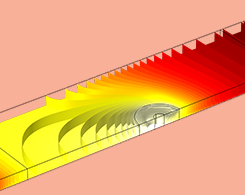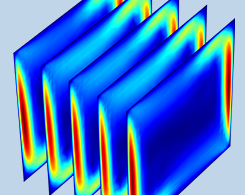Blog Posts Tagged Heat Transfer Module

Examining Heat Transfer in a Friction Stir Welding Process
Friction stir welding (FSW) is an efficient, cost effective, and environmentally friendly process that can be optimized by studying the heat transfer involved via modeling.

Optimizing Thermal Processes in Carbon Manufacturing with Simulation
A guest blogger from SGL Carbon GmbH demonstrates how his organization uses heat transfer simulation to optimize thermal processes in carbon manufacturing.

Common Pitfalls in Electrothermal Analysis
In the real world, electromagnetic heating often involves a nonlinear temperature. Learn some common pitfalls that occur during this type of electrothermal analysis and how to overcome them.

Using the Inflow Boundary Condition in Nonisothermal Flow Simulations
Nonisothermal flow is a multiphysics problem, as it combines CFD and heat transfer analysis. Learn how to implement the Inflow boundary condition when simulating these types of scenarios.

Modeling Phase Change in a Thermosiphon
A guest blogger from Noumenon Multiphysics writes about modeling phase change in a thermosiphon, a device that has been keeping houses warm since the 1800s.

Advancing Additive Manufacturing with Sequential Simulations
In some ways, additive manufacturing is like sewing or weaving. We talk to a professor of additive manufacturing about how sequential simulations can be used to analyze and optimize the process.

Comparing Static and Dynamic Wall Heat Exchangers with Simulation
We compare the performance and efficiency of static and dynamic compact wall heat exchanger designs using fluid-structure interaction.

Simulating Natural Convection in Air with COMSOL Multiphysics®
From small electronic components to large buildings, natural convection is a transport phenomena found in engineering disciplines of all sizes. Here’s an example of natural convection in air.
